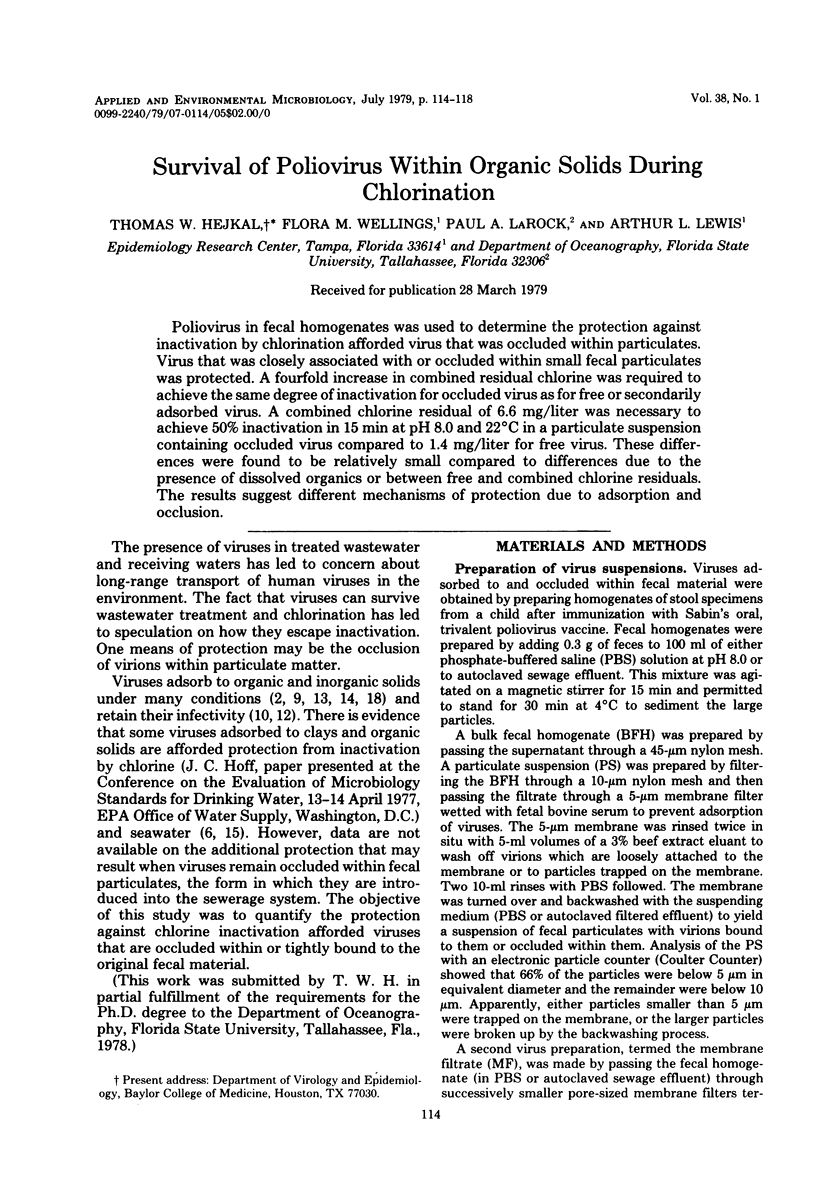Abstract
Poliovirus in fecal homogenates was used to determine the protection against inactivation by chlorination afforded virus that was occluded within particulates. Virus that was closely associated with or occluded within small fecal particulates was protected. A fourfold increase in combined residual chlorine was required to achieve the same degree of inactivation for occluded virus as for free or secondarily adsorbed virus. A combined chlorine residual of 6.6 mg/liter was necessary to achieve 50% inactivation in 15 min at pH 8.0 and 22 degrees C in a particulate suspension containing occluded virus compared to 1.4 mg/liter for free virus. These differences were found to be relatively small compared to differences due to the presence of dissolved organics or between free and combined chlorine residuals. The results suggest different mechanisms of protection due to adsorption and occlusion.
Full text
PDF




Selected References
These references are in PubMed. This may not be the complete list of references from this article.
- Boardman G. D., Sproul O. J. Protection of viruses during disinfection by adsorption to particulate matter. J Water Pollut Control Fed. 1977 Aug;49(8):1857–1861. [PubMed] [Google Scholar]
- Cramer W. N., Kawata K., Krusé C. W. Chlorination and iodination of poliovirus and f2. J Water Pollut Control Fed. 1976 Jan;48(1):61–76. [PubMed] [Google Scholar]
- Dahling D. R., Berg G., Berman D. BGM, a continuous cell line more sensitive than primary rhesus and African green kidney cells for the recovery of viruses from water. Health Lab Sci. 1974 Oct;11(4):275–282. [PubMed] [Google Scholar]
- Gerba C. P., Schaiberger G. E. Effect of particulates on virus survival in seawater. J Water Pollut Control Fed. 1975 Jan;47(1):93–103. [PubMed] [Google Scholar]
- KELLY S. M., SANDERSON W. W. The effect of chlorine in water on enteric viruses. II. The effect of combined chlorine on poliomyelitis and Coxsackie viruses. Am J Public Health Nations Health. 1960 Jan;50:14–20. doi: 10.2105/ajph.50.1.14. [DOI] [PMC free article] [PubMed] [Google Scholar]
- KELLY S., SANDERSON W. W. The effect of chlorine in water on enteric viruses. Am J Public Health Nations Health. 1958 Oct;48(10):1323–1334. doi: 10.2105/ajph.48.10.1323. [DOI] [PMC free article] [PubMed] [Google Scholar]
- Schaub S. A., Sagik B. P. Association of enteroviruses with natural and artificially introduced colloidal solids in water and infectivity of solids-associated virions. Appl Microbiol. 1975 Aug;30(2):212–222. doi: 10.1128/am.30.2.212-222.1975. [DOI] [PMC free article] [PubMed] [Google Scholar]
- Smith E. M., Gerba C. P., Melnick J. L. Role of sediment in the persistence of enteroviruses in the estuarine environment. Appl Environ Microbiol. 1978 Apr;35(4):685–689. doi: 10.1128/aem.35.4.685-689.1978. [DOI] [PMC free article] [PubMed] [Google Scholar]
- Stagg C. H., Wallis C., Ward C. H. Inactivation of clay-associated bacteriophage MS-2 by chlorine. Appl Environ Microbiol. 1977 Feb;33(2):385–391. doi: 10.1128/aem.33.2.385-391.1977. [DOI] [PMC free article] [PubMed] [Google Scholar]
- Wellings F. M., Lewis A. L., Mountain C. W. Demonstration of solids-associated virus in wastewater and sludge. Appl Environ Microbiol. 1976 Mar;31(3):354–358. doi: 10.1128/aem.31.3.354-358.1976. [DOI] [PMC free article] [PubMed] [Google Scholar]


